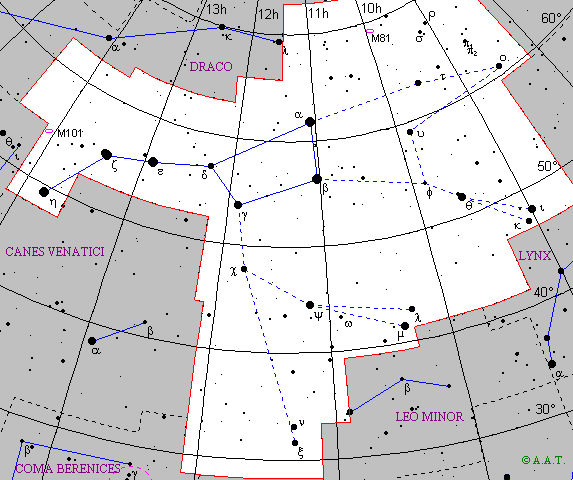 |
 |
| English name | Great Bear, Plough or Big Dipper | ||||
|---|---|---|---|---|---|
| Major stars | alpha Ursae Maioris | Dubhe | magn. 2,0 | RA: 11h 03m 43.73s | Dec: +61° 45' 03.3" |
| beta Ursae Maioris | Merak | magn. 2,4 | RA: 11h 01m 50.47s | Dec: +56° 22' 56.5" | |
| gamma Ursae Maioris | Phecda | magn. 2,5 | RA: 11h 53m 49.81s | Dec: +53° 41' 41.1" | |
| delta Ursae Maioris | Megrez | magn. 3,4 | RA: 12h 15m 25.54s | Dec: +57° 01' 57.3" | |
| epsilon Ursae Maioris | Alioth | magn. 1,7 | RA: 12h 54m 01.73s | Dec: +55° 57' 35.6" | |
| zeta Ursae Maioris | Mizar | magn. 2,4 | RA: 13h 23m 55.52s | Dec: +54° 55' 31.4" | |
| eta Ursae Maioris | Alkaid | magn. 1,9 | RA: 13h 47m 32.47s | Dec: +49° 18' 48.1" | |
| theta Ursae Maioris | magn. 3,3 | RA: 09h 32m 51.64s | Dec: +51° 40' 39.5" | ||
| iota Ursae Maioris | Talitha | magn. 3,1 | RA: 08h 59m 12.55s | Dec: +48° 02' 30.3" | |
| lambda Ursae Maioris | Tania Borealis | magn. 3,5 | RA: 10h 17m 05.83s | Dec: +42° 54' 51.9" | |
| my Ursae Maioris | Tania Australis | magn. 3,2 | RA: 10h 22m 19.76s | Dec: +41° 29' 58.2" | |
| omicron Ursae Maioris | Muscida | magn. 3,5 | RA: 08h 30m 15.92s | Dec: +60° 43' 05.7" | |
| psi Ursae Maioris | magn. 3,1 | RA: 11h 09m 39.80s | Dec: +44° 29' 54.7" | ||
| Description | Important constellation of the northern hemisphere, third in order of extension, after Hydra and Virgo. Thanks to a group of seven stars (from alpha to eta Ursae Maioris), that draw the figure known as Plough or Big Dipper, Ursa Maior is perhaps the most famous and well known constellation of the whole sky. The first two stars of the dipper, Dubhe and Merak, are useful to find the North Pole, since the line that contains them directs toward the Polaris, in Ursa Minor. The second star of the beam, Mizar, is a multiple star. To the naked eye we succeed in seeing a companion of fourth magnitude, Alcor; and with a small telescope we can perceive another star of fourth magnitude, near Mizar. And since every of these three stars is a double, as spectroscopic observations reveal, this is a system with well six stars. Another interesting double star is xi Ursae Maioris, in the southern zone of the constellation, near Leo: it is a couple of yellow stars which rotate round each other with a 60-year period.
|
||||
| Mythology and history | According to Eratostenes and Ovid, the constellation represents the animal into which was changed Callisto, mother of Arcas (see the mythology of Bootes). Aratus, instead, affirms that the constellation must be identified with one of the two nymphs who raised the new-born Zeus: her name was Adrastea, while the other one was Ida, represented by Ursa Minor. Aratus, however, doesn't explain why these nymphs were changed into she-bears. An enigma that unites the two heavenly she-bears is representes by the long tails, which have nothing in common with the shorter tails of the true bears. Thomas Hood, an English astronomer of the XVI century, ironically justified this detail by saying that such extremities grew longer when Zeus lifted the she-bears to put them in the sky, just grasping their tails. |
||||
 Back to constellations page.
Back to constellations page.